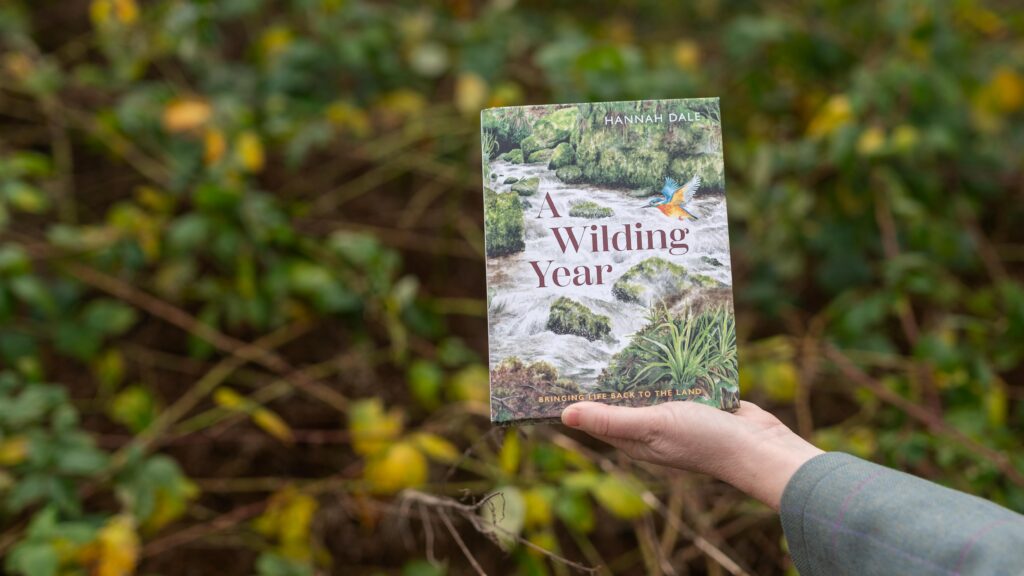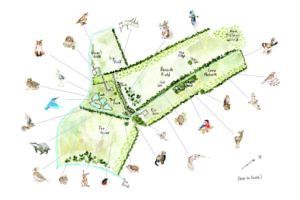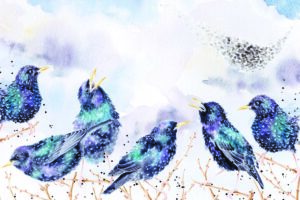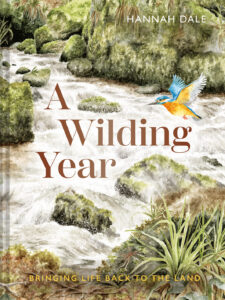Hannah Dale’s rewilding journey

To celebrate the publication of A Wilding Year, we’re sharing Hannah’s inspiring introduction to her rewilding journey, taken from the beginning of the book.
By Hannah Dale.

In 2015, my husband Jack inherited a small farm in Lincolnshire. It was unexpected and unwanted – the result of his dad’s short and intense battle with a brain tumour that took a kind and inspirational man far too soon.
The land Jack inherited possesses in abundance what his dad affectionately referred to as ‘character’. Claimed from marshy wetlands by the drainage experts of the 17th century, it is stubborn ground that does not want to be cajoled into producing food for its human custodians. It is clear that the land wants to embrace its natural inclination to be wet, despite the best efforts of land drains and ditches. Much of it sits under water during the winter before the clay soil bakes hard in the summer, opening up deep fissures and strangling anything that tries to grow in its inhospitable tilth.
Despite the challenges, for the first few years we tried unsuccessfully to generate a profitable harvest from the land. The stress of watching the weather is an occupational hazard for all farmers, and it is invariably too wet, too hot, too cold or too dry at any one time, but the frustration of watching a crop of winter wheat drown under stagnant water, or trying to persuade a seed to germinate on dusty baked-hard ground, was painful and we started to think about other ways the land might be used.
In 2018, Jack read Wilding by Isabella Tree, a book that documents the transformation of an unprofitable arable farm over a period of 20 years into a rich mosaic of habitats offering refuge to a large number of species clinging on to the last vestiges of suitable territory that exist at the fringes of the environment we have shaped. The principle of ‘rewilding’ is to restore ecosystems to the point that nature can take care of itself and we both found the book and the concept incredibly inspiring. We felt that our poor, unproductive land was an ideal candidate for rewilding. Rather than losing money year after year trying to grow crops, it could be better put to use for the benefit of nature. We also felt that it was a fitting way to honour Jack’s dad, who loved the countryside and was an early pioneer of regenerative farming. He had spent a large part of his career developing a seed drill that negates the need for ploughing, thereby protecting the soil structure and preserving his beloved earthworms in the process.

As a wildlife illustrator and having studied Zoology at Cambridge University, I spend much of my time in the Lincolnshire countryside, and the idea of allowing our farm to stop fighting against its natural instincts and letting nature flow back in was incredibly appealing. Over the past few years, I can’t be alone in having experienced severe anxiety related to the climate and biodiversity emergencies that we are facing, and the catastrophic collapse of so many species that shows no sign of abating. The loss of wildlife abundance we have experienced in Britain has outpaced almost everywhere else in the world*, and a re-setting of expectations establishes a new baseline for each generation, meaning that we can’t even remember what we have lost. Far from being a stable situation, many species are still in free fall and without the protection that exists from being part of a large colony or connected, functioning ecosystem, the few isolated breeding pairs still clinging on to fragments of habitat that remain have little hope of recovery. Successful reintroductions and an overwhelming love of the natural world among the British people offer beacons of hope, but the slow response of government and denials from people who prefer to bury their heads in the sand or have vested interests in maintaining the status quo, are both frustrating and heart-wrenching.
In July 2019, we took the final harvest from our soil and tentatively stood back to see what would happen. We planted trees, dug ponds and scattered locally sourced, native wildflower seeds to try and replenish the depleted seedbank. Above all, we began allowing the land to express its own character, and to start the process of healing itself.
Ceasing cultivation, spraying and fertilizing is now allowing the regeneration of scrub, a vital habitat largely missing from our countryside. Within a few short years, our unfettered hedgerows are now festooned with blossom in spring and burgeoning with berries in autumn. The soils crawl and the grasses fizz with insects. In summer, clouds of meadow brown butterflies numbering well over a thousand billow over patches of creeping thistles. The birdsong in spring has exploded in volume as more food availability means more successful breeding seasons. Barn owls hunt over messy grass wriggling with voles where once a sterile bed nursed its monoculture of wheat, like a meadow pipit feeding a cuckoo chick in its nest that doesn’t belong there.
We planted trees, dug ponds and scattered locally sourced, native wildflower seeds to try and replenish the depleted seedbank. Above all, we began allowing the land to express its own character, and to start the process of healing itself.
As an artist, our return to wildness has provided me with an unlimited source of inspiration, and spending time on the farm with a sketchbook provides both a cathartic relief from the stresses of daily life and a source of new paintings. My artwork has always been inspired by nature, interwoven with a dose of imagination for good measure and this book is both a journal and a sketchbook, capturing glimpses of the characters that have joined us here at Low Farm over the course of a year. I hope that bringing them to life in both words and art encourages more people to see beauty in an untidy landscape and to embrace a little more wildness in their lives.
More about A Wilding Year:
Follow Hannah Dale’s deeply personal journey as she returns her Lincolnshire farm to nature, celebrating the return of an astonishing variety of wildlife.
Hannah Dale, the artist and founder of the award-winning nature-centric gift company Wrendale Designs, takes you through a year on her farm in rural Lincolnshire where, alongside her husband, she has undertaken an ambitious rewilding project. Together, they are attempting to return the land to nature and increase the number of species their land is able to support.
A Wilding Year explores how one family have been able to embrace the beauty to be found in untidy landscapes, heralding the return of skylarks, meadow pipits, hobbies, polecats and many more species to their farm. The land was originally claimed from marshy wetlands, and leaning into the land’s natural inclination to be wet has also yielded amazing ponds and pond life.
A Wilding Year by Hannah Dale is available to purchase online here, from the Wrendale Designs shop and from all good booksellers.


